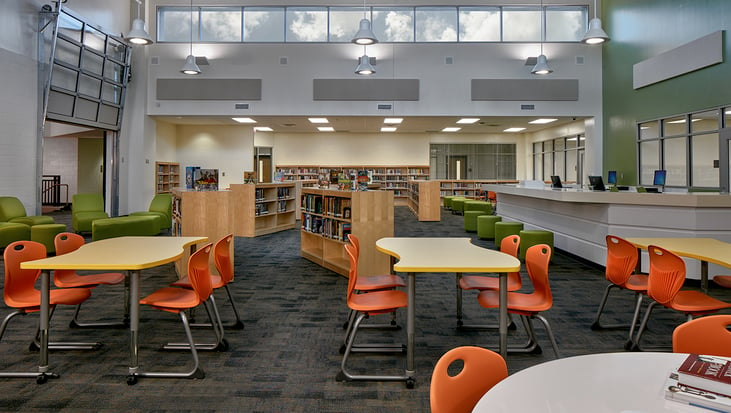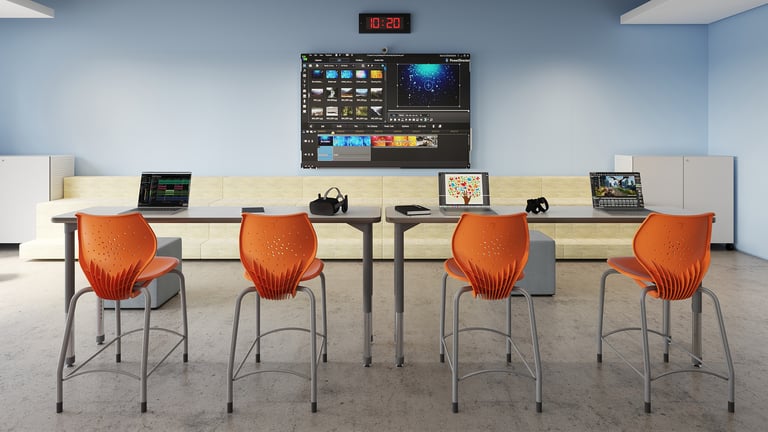the hub of the school
Supporting the community's unique needs, what once was a library is now a center of activity. These flexible spaces need to accommodate technology, house research and reading materials, and stimulate creativity with STEM and STEAM areas, quiet areas for independent reflection, and social areas for small and large group learning activities.
As you plan your media center, think about how it will function, how it supports student learning outcomes, and how it will make students feel. To get you started download the planning guide.

creating collaborative spaces: designing media centers to promote collaboration among students
In order to design a media center that promotes collaboration among students, it is important to prioritize flexible furniture and layouts. Adaptable furniture allows for easy reconfiguration, creating spaces that can easily accommodate small and large group activities. By incorporating dedicated spaces for group work, media centers can provide students with the opportunity to collaborate and engage in meaningful discussions. Additionally, media-rich centers that blend print collections and media resources offer new opportunities for creativity and innovation.
The use of flexible and mobile furnishings, such as tables and shelving on casters, allows for easy changes to the physical space based on the needs of the occupants. Furthermore, creating fun spaces for students to connect, like using floor seating options, can foster a sense of community and encourage collaboration. By considering these design elements, media centers can become vibrant hubs of activity that promote collaboration and enhance student learning outcomes.

helpful links
- Learning from Retail Design: Enhancing Library Spaces for Engagement and Exploration
- Learning Environments That Promote Student Safety and Security
- Develop Social + Interpersonal Skills with These Classroom Setup Ideas
- Color Inspiration Guide
- Planning Typicals
EXPLORE media centers
Click through various flexible learning environments below or visit our image gallery of media centers designed to promote creativity and innovation.

MEDIA RICH CENTERS
Media-rich centers provide new opportunities for creativity. Blending print collections and media resources gives space to move. Flexible and mobile furnishing eliminate barriers.

QUIET REFLECTION
Enhance the design of the space with furniture that encourages students to experience the thoughtful design.

FLEXIBLE + MOBILE FURNISHINGS
Flexible and mobile furnishings create inviting spaces. Tables and shelving on casters let you change on the fly. This physical space adapts to the needs of the occupants instead of the other way around.

FUN SPACES FOR STUDENTS TO CONNECT
Use floor seating as an option in the media center.

MOBILE SHELVING NEEDS STABILITY
Shelving will not shift or move with strong magnetic holds.

EXPLORE ON YOUR OWN
Maker space labs allow a small group of students to explore outside of typical classroom work. A sturdy maker space table and ample storage for supplies are all you need.

DISTANCE LEARNING OR TELECON MEETING?
Create small spaces where students or staff can meet and collaborate. A table and some comfortable chairs are all that's required.

QUIET RETREAT
Small group learning environments provide students space to demonstrate mastery by creating and presenting projects that simulate real research methods.

"HUDDLE" ROOMS
provide students or staff a place to meet over projects or allow privacy for assessment testing. A few desks and comfortable soft seating that can be reconfigured lends to the relaxed, low-stress environment.

WORK ON PROJECTS
Create a project space in a media center where students can spend time working on presentations and art projects. Versatile 3P-120 Shape Table works for 3 students with proper social distancing now and more later. Round Rockers and Arcs provide a fun seating option.

WALK UP WORK
A standing racetrack café table in a breakout room gives students a chance to change positions while working on projects.

MIX UP HEIGHTS
Movement is important to increase respiration and blood flow. Use floor seating and reduced height work surfaces to encourage floor work.

USE EXTRA SPACE
Creative use of furniture can help teachers maximize learning. Standing height desks paired with café stools allow students a space to learn that meets their needs.
preparing students for success
Breakout spaces are invaluable additions to learning environments, revolutionizing the way students interact, collaborate, and learn. By embracing these spaces, educational institutions empower students to actively participate in their education, develop essential skills, and unleash their creative potential. As we continue to adapt to the changing educational landscape, breakout spaces represent a significant step forward in creating dynamic and engaging learning environments that prepare students for success in the modern world.



